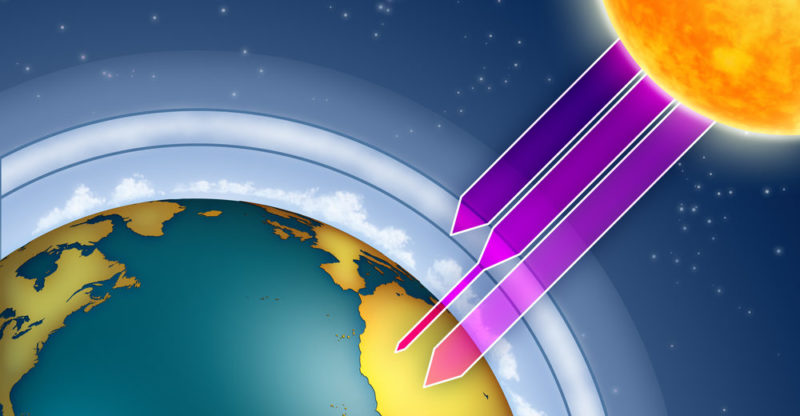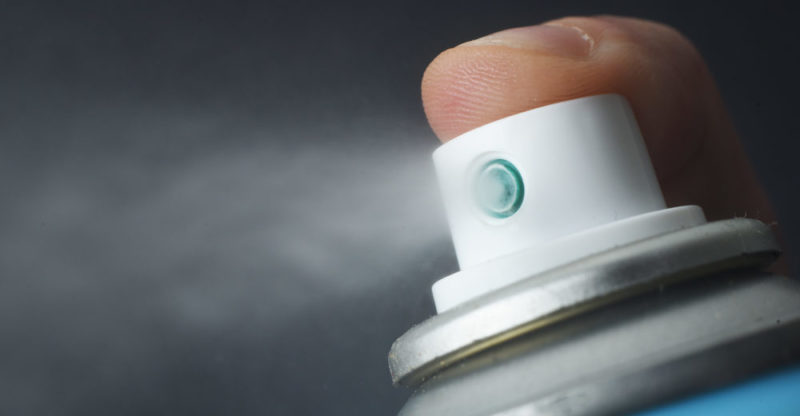We explain what the ozone layer is and its characteristics. Also, how to protect it, what is the ozone hole, its consequences and more.
What is the ozone layer?
The ozone layer is one of the areas of the atmosphere of the Earth that is known for its high concentration of ozone . It ranges from about 15 kilometers from the ground to 45 kilometers high. It is also called the ozonosphere .
The function of the ozone layer is to shield protector because it is able to filter out most ultraviolet radiation high frequency that comes from the light sun. Some of the radiation is necessary for the development of life , but in too much intensity it is harmful.
The ozone layer was discovered by the French physicists Charles Fabry and Henri Buisson in 1913. The British physicist Gordon MB Dobson created, in 1924, a measurement system to calculate the thickness of the ozone layer, in which a Dobson unit ( DU) is equivalent to 0.01 millimeter of thickness under normal pressure and temperature conditions.
Characteristics of the ozone layer
Among the main characteristics of the ozone layer, the following stand out:
- It has a gas composition containing molecules of ozone with three atoms of oxygen .
- It is located in the stratosphere , which is the second closest layer to the Earth's surface of the five layers that make up the atmosphere.
- It extends from 15 km from the earth's surface to a distance of 45 km.
- It is essential for life because it filters out most of the ultraviolet rays that come from sunlight and are harmful to living beings .
- It is measurable through a spectrophotometer in which the unit of measurement is Dobson (DU) and is equal to 0.01 millimeter.
- It has a high temperature due to the absorption and concentration of solar radiation.
What is the ozone hole?

The ozone hole is a damaged area of the layer that has a lower density or depletion of ozone molecules, which allows the passage of harmful ultraviolet rays to the earth's surface.
The rate of ultraviolet light that reaches the Earth's surface depends on the concentration of ozone in the stratosphere and also on the interaction of other factors, such as the time of day (between 10 a.m. and 4 p.m. the sun's rays impact with greater power) and the season of the year.
The causes of ozone holes are of two types:
- Natural causes. They correspond to phenomena that can alter the concentration of ozone molecules. For example: volcanic eruptions, stratospheric air currents , solar activity or low temperatures that increase the levels of chlorine and bromine in the air and that are capable of disintegrating ozone. Despite these phenomena, under natural conditions and due to the passage of time, the damaged layer should be recovered. But when human action interferes with harmful actions and intensively the problem worsens.
- Causes by human action. They correspond to activities and actions carried out by human beings and that are detrimental to the ozone layer. For example: gases capable of disintegrating ozone that are released by transportation, by manufacturing industries and by derivatives of saturated hydrocarbons or oil that are used in industrial refrigeration equipment or in aerosols. These components can remain in the atmosphere for between 50 and 200 years.
However, if the ozone hole of natural origin is added to the excessive actions of the human being with the use of chemical and organic substances that are capable of disintegrating ozone molecules, the magnitude of the damage becomes irreversible.
Starting in the 1970s, scientists detected that the concentration of ozone molecules was decreasing in various areas of the ozonosphere, especially in the polar regions.
In 1987, the “Montreal Protocol” was signed in Canada, which consisted of an international environmental agreement between representatives of various nations before the United Nations (UN). The agreement established a commitment to reduce the production and consumption of various substances that are harmful to the ozone layer.
At present, the ozone layer has recovered gradually, in part, due to the regulations implemented at the international level that regulate the activities of commercialization and use of substances that damage the ozone layer and due to the greater intake social awareness, especially in the use of aerosols.
Consequences of the ozone hole
The ozone hole, that is, the decrease in ozone concentration in the stratosphere, allows the passage of high frequency ultraviolet rays that are harmful to human health , because they cause serious consequences such as: skin diseases, diseases vision and damage to the immune system .
Substances harmful to the ozone layer
 Among the main substances harmful to the ozone layer that are used by humans are:
Among the main substances harmful to the ozone layer that are used by humans are:
- Chlorofluorocarbon (CFC). It is a chemical compound that contains chlorine, fluorine and carbon derived from saturated hydrocarbons or petroleum . It is one of the main causes of the disintegration of the ozone layer, because it can completely dissolve ozone molecules. It is usually used in all types of aerosols, solvents and air conditioners, among other uses.
- Hydrochlorofluorocarbon (HCFC). It is a compound similar to CFC capable of damaging the ozone layer with the difference that, in addition to chlorine, fluorine and carbon, it contains hydrogen that makes chlorine molecules more unstable when they come into contact with ozone molecules in the stratosphere .
- Carbon dioxide . It is a gas that is found naturally in the atmosphere and that retains the heat of the sun and thus maintains a suitable temperature for life. The excess of carbon dioxide (CO 2 ) in the atmosphere, which is emanated by human actions through petroleum-derived fuels, causes the greenhouse effect , that is, greater retention of the sun's heat. If to this is added the ozone hole that lets through more ultraviolet radiation, the retention of heat in the atmosphere intensifies, altering the development of life on Earth.
- Methyl bromide. It is a halogenated organic compound with a gaseous structure that is used in the agricultural industry to control pests and to disinfect crop soils. According to scientific studies, the use in considerable doses does not imply harm to human health, although it does not exempt it from being harmful to other species. However, it does affect the ozone layer.
- Methylchloroform or trichloroethane. It is a substance that is currently prohibited for causing intoxication in living beings that have inhaled it and for damaging the ozone layer. It is an organic compound based on a complex mixture of hydrocarbons, with a liquid structure and an intense odor that was used as a solvent in industries.
- Carbon chloride or tetrachloride. It is a gaseous synthetic chemical compound that is currently prohibited due to its high level of toxicity to water , air and soil. It was used as a fire extinguisher and in the production of refrigerants.
How to avoid damage to the ozone layer?
 Some recommendations to avoid damage to the ozone layer are:
Some recommendations to avoid damage to the ozone layer are:
- Stop consuming aerosols and solvents that contain chlorofluorocarbons (CFCs) among their components.
- Avoid repairing appliances that do not respect current environmental standards and protocols , such as refrigerators or air conditioning systems. During the handling of the equipment, chlorofluorocarbon (CFC) particles can be released into the environment .
- Encourage the planting of native trees that help clean the air and absorb carbon dioxide, which is one of the great factors that damages the ozone layer and contributes to the greenhouse effect.
- Require governments to implement stricter environmental standards that contribute to a toxic-free lifestyle for industry, consumption and public awareness.
The above content published at Collaborative Research Group is for informational and educational purposes only and has been developed by referring reliable sources and recommendations from experts. We do not have any contact with official entities nor do we intend to replace the information that they emit.
MA student of the TransAtlantic Masters program at UNC-Chapel Hill. Political Science with a focus on European Studies. Expressed ideas are open to revision. He not only covers Technical articles but also has skills in the fields of SEO, graphics, web development and coding. .
Leave a reply
Your email address will not be published. Required fields are marked *Recent post

Sport: What Is It, Types, Risks, Features, Characteristics and Examples

Dogs: Emergence, Features, Characteristics, Feeding and Breeds

Story: Definition, Elements, Structure, Features and Characteristics

